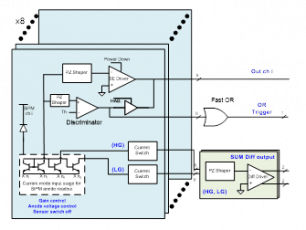
Summation for multi-channel photomultiplier array signals
Advantages
- Patented wideband readout circuit allowing high speed, high dynamic range and low noise summing.
- Low operating voltage (3.3V), with low power consumption (30mW for individual channel and 200mW for summation).
- On-chip anode voltage control allowing equalization of over-voltage of each SiPM.
- Possibility of selecting individual pixels of the SiPM array.
- Operation with distinct SiPM signals with different time constants.
- PZ cancellation can be used or bypassed in any operation mode.
Applications
This summation circuit is useful is any application requiring high speed ultrasensitive (single photon) photo-sensors with large detection area (≥ 1 cm2) like in medical imaging (PET, SPECT, γ-camera), spectrophotometers, fluorescence microscopy, telescopes, radiation detection, scientific installations (synchrotron, particle accelerators), etc. As an example, the “MUSIC” (“Multiple Use SiPM Integrated Circuit “) ASIC is being studied as a beam loss monitor in the ALBA synchrotron facilities.
Goal
Partners are sought to further develop the technology through a co-development and license agreement.
Patent
International Patent Application
Reference
AVCRI262 (MUSIC)
Contact
Eva Martín, PhD
Email: emartin@fbg.ub.edu
Tel: +34 934 037 257
Summation for multi-channel photomultiplier array signals
Executive summary
Researchers from the University of Barcelona have developed a multi-purpose circuit aimed at summing signals received from a Silicon photomultiplier (SiPM) array. This sum is performed at high speed, high dynamic range and low noise, and the particular design of the circuit allows working at a lower voltage. The team is keen to collaborate with suitable partners for development of the technology. A pre-industrial prototype has been designed and built for several applications, such as radiation detectors, medical imaging or Cherenkov telescope arrays.
Introduction
Nowadays, ultrasensitive photo-sensors like Silicon photomultipliers (SiPMs) are replacing photomultiplier tubes (PMT) in many applications due to their compactness and lower operating voltage required. As PMT have a larger active area as compared with SiPM, this replacement requires the substitution of one PMT with an array of several SiPM, especially in applications requiring large detection surface. Direct connection of each channel is problematic due to their lack of uniformity and the increasing number of channels to cover a similar area as a PMT. It is convenient to sum the signals of the multiple channels to simplify the complexity of the subsequent electronics. The present invention provides a summation circuit for photomultiplier arrays.
Description
An 8 channel ASIC based on a novel low input impedance current conveyor is employed for SiPM anode readout. The current mode input stage presents low series noise, high bandwidth, high dynamic range and allows operating SiPMs at high overvoltage. The control of each SiPM channel overvoltage allows a higher gain and PDE uniformity. Combining these characteristics, it is possible to achieve excellent time resolution and Signal to Noise Ratio.
The integrated circuit offers three main features: (1) SiPM pixel summing in differential mode; (2) individual analog single ended (SE) channels; and (3) binary output encoding the amount of collected charge in the duration of the digital signal using a non-linear time over threshold (ToT) technique (one A/D is selectable per channel). Moreover, a trigger pulse is provided by performing an OR between all binary signals. Lastly, the ASIC includes a tuneable Pole Zero Cancellation (PZ) of the SiPM recovery time constants to adapt to sensors from different manufacturers. Decay times up to 100 ns are supported covering most of the available SiPM devices in the market. The PZ reduces the peak duration of the signal and the tail produced by the sensor, thus reducing spill-over (two events overlapped due to slow tails).
Current stage of development
A pre-industrial prototype has been designed and built for scientific applications. Several prototype boards are being currently used by independent groups to be used, for instance, as a beam loss monitor or as ToF timing detector in the SHIP experiment at CERN.
A new prototype is being under development with further improvements such as lower power consumption, multiple summation combinations and summation output with linearized ToT. Linear ToT will allow direct interface with programmable logic, which is optimal for low cost and reconfigurable systems.


